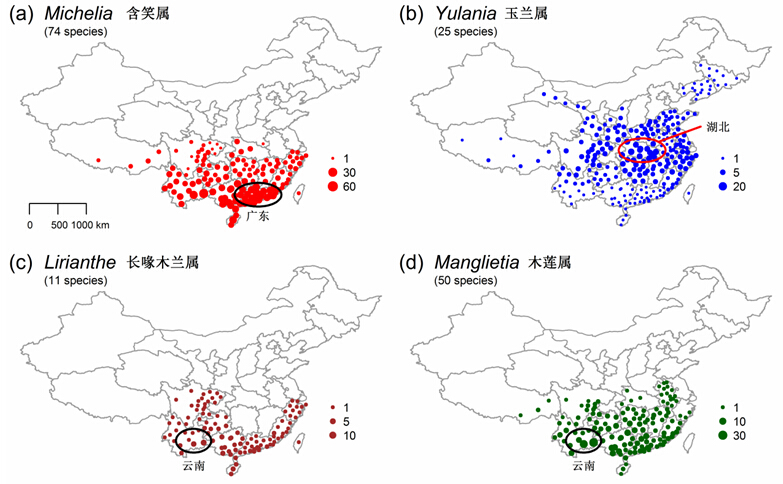J Biogeogr:中科院华南植物园叶清研究组揭示木兰科植物功能性状
2016年2月15日,国际生态学期刊《Journal of Biogeography》杂志上在线发表了中国科学院中国科学院华南植物园生态及环境科学研究中心叶清领衔的植物水分生理生态研究组的一篇研究论文,研究揭示了木兰科植物功能性状-系统发育-生物地理关系。助理研究员刘慧为论文第一作者,叶清研究员为论文通讯作者。
分析系统发育、环境限制和性状变异之间的关系可以揭示物种分布是如何形成的,木兰科植物作为早期分化的类群,其广泛的地理分布是由进化背景还是空间限制主导尚不清楚。
研究组助理研究员刘慧,以分布在中国的183种木兰科植物为研究对象,基于15个功能性状和12个环境因子,构建了4个系统发育-生物地理模型,以检验系统发育和空间距离对各指标的解释程度。研究发现:1、中国木兰科物种分布从南向北依次减少,东南沿海、华北和华中是系统发育聚集分布的地区;2、平均胸径、叶片生活型和形态指标、花叶生长顺序、平均和最小年均温、最小年均降水量具有很强系统发育信号;3、平均胸径、叶片和花瓣的大小、果实长度和系统发育距离密切相关,而株高、花果期及12个环境因子(海拔、年均温和年降水量的最大、最小、平均值和范围)同时与空间距离和系统发育距离密切相关。
研究结果表明大多数木兰科植物功能性状具有系统发育生态位保守性,环境因子具有较弱的系统发育信号和较强的空间信号,因此木兰科植物的温带-热带分布格局是在地理隔离和环境限制条件下,通过植物的生理生态适应所形成,反映了系统发育和空间距离对几个类群趋异分布的共同作用(如图)。

中国木兰科四大属的趋异分布情况。三个分布中心在广东、湖北和云南,圆点大小代表物种数。
原文链接:
Uncovering the spatio-temporal drivers of species trait variances: a case study of MagnoliAceae in China
原文摘要:
Aim
Analyses of the relationships between evolutionary history, environmental constraints and associated trait variances can reveal how species distributions were shaped. Phylogenetic comparative models can be used to disentangle the relative roles of spatial and phylogenetic factors in explaining trait variances. Here, we analyse variances in plant traits and environmental variables of the widely distributed and early diverging Magnoliaceae within a phylogeographical context to test whether species distributions have been limited more by evolutionary or spatial constraints in this family.
Location
China.
Methods
The phylogenetic relatedness and geographical distributions of 183 Magnoliaceae species in China were analysed for phylogenetic clustering or over-dispersion. The phylogenetic signals of 15 plant traits and 12 environmental variables were determined, and the relative contributions of phylogeny and space to each quantitative trait were distinguished using four comparative models.
Results
Species richness gradually decreased from south to north, with phylogenetic clustering along the southern coast, and in northern and central China. Strong phylogenetic signals were found in leaf form, flowering sequence, diameter at breast height, leaf length and width, mean and minimum mean annual temperature, and minimum mean annual precipitation. Variances of plant diameter, length and width of leaves and tepals, and fruit length were strongly associated with phylogenetic relatedness. In contrast, variances of plant height, flowering and fruiting time, and all of the 12 environmental variables (mean, minimum, maximum and range of altitude, temperature and precipitation) were associated with both spatial proximity and phylogenetic distance between species.
Main conclusions
Phylogenetic niche conservatism was identified in most of the studied plant traits across the Magnoliaceae. In contrast, environmental variables showed weak phylogenetic signals, but strong spatial signals. These results suggest that the present tropical-temperate distributional pattern of the Magnoliaceae is driven by the ecophysiological adaptation of plant traits under both geographical separation and environmental constraints.
作者:叶清

